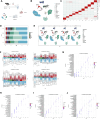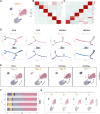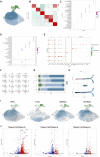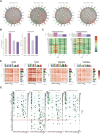snRNA-seq reveals subcutaneous white adipose tissue remodeling upon return to thermoneutrality after cold stimulation
- PMID: 40476003
- PMCID: PMC12138199
- DOI: 10.3389/fcell.2025.1578180
snRNA-seq reveals subcutaneous white adipose tissue remodeling upon return to thermoneutrality after cold stimulation
Abstract
Introduction: Cold stimulation induces browning of subcutaneous white adipose tissue (sWAT), making it a prime target for treating obesity and metabolic disorders. However, this remodeling is reversible: upon return to thermoneutrality (rewarming), sWAT whitens and loses its enhanced metabolic functions. Given the limited understanding of the microscopic dynamic changes and underlying mechanisms during this process, we established a temporally dynamic mouse model spanning the entire period from cold stimulation to the return to thermoneutrality, with inguinal sWAT (iWAT) selected as the study subject.
Methods: Based on preliminary data demonstrating stabilization in iWAT histology, expression levels of key thermogenic proteins, and the bulk transcriptome, we selected the two-week time point after the return to thermoneutrality for detailed analysis. Subsequently, we employed single-nucleus RNA sequencing (snRNA-seq) to comprehensively characterize iWAT cellular dynamics during cold stimulation and the subsequent two-week period after the return to thermoneutrality.
Results: Our findings revealed that while iWAT phenotypically reverts to a white state after 2 weeks of rewarming, as evidenced by structural, functional, and bulk transcriptomic characteristics, significant cold-induced molecular and cellular signatures persist. Specifically, we observed altered differentiation trajectories in both adipose stem and progenitor cells (ASPCs) and adipocytes, suggesting dedifferentiation and reprogramming tendencies. Furthermore, the ANGPTL signaling pathway, activated in thermogenic adipocyte subpopulation A3 during cold stimulation, remained active and influenced cell-cell communication even after the loss of thermogenic capacity.
Discussion: hese findings provide novel insights into elucidating the complex cellular and molecular mechanisms underlying the temperature-dependent plasticity of iWAT, and suggest that the ANGPTL signaling pathway may play a potential role in maintaining the white phenotype of iWAT after withdrawal from cold stimulation.
Keywords: cold stimulation; plasticity; single-nucleus RNA sequencing; subcutaneous white adipose tissue; thermoneutrality.
Copyright © 2025 Yang, Zhang, Yi, Yang, Wu, Zhang, Zhang, Li, Wu, Li and Yang.
Conflict of interest statement
The authors declare that the research was conducted in the absence of any commercial or financial relationships that could be construed as a potential conflict of interest.
Figures






Similar articles
-
Cold-Induced Reprogramming of Subcutaneous White Adipose Tissue Assessed by Single-Cell and Single-Nucleus RNA Sequencing.Research (Wash D C). 2023 Jun 28;6:0182. doi: 10.34133/research.0182. eCollection 2023. Research (Wash D C). 2023. PMID: 37398933 Free PMC article.
-
Adipocyte-specific mTORC2 deficiency impairs BAT and iWAT thermogenic capacity without affecting glucose uptake and energy expenditure in cold-acclimated mice.Am J Physiol Endocrinol Metab. 2021 Nov 1;321(5):E592-E605. doi: 10.1152/ajpendo.00587.2020. Epub 2021 Sep 20. Am J Physiol Endocrinol Metab. 2021. PMID: 34541875
-
Bone morphogenic protein 9 is a novel thermogenic hepatokine secreted in response to cold exposure.Metabolism. 2022 Apr;129:155139. doi: 10.1016/j.metabol.2022.155139. Epub 2022 Jan 19. Metabolism. 2022. PMID: 35063533
-
Transplantation of Cold-Stimulated Subcutaneous Adipose Tissue Improves Fat Retention and Recipient Metabolism.Aesthet Surg J. 2024 Jun 14;44(7):NP486-NP500. doi: 10.1093/asj/sjae070. Aesthet Surg J. 2024. PMID: 38518754
-
Single-nucleus RNA sequencing reveals dynamic changes in the microenvironment of visceral adipose tissue and metabolic characteristics after cold exposure.Front Endocrinol (Lausanne). 2025 Mar 24;16:1562431. doi: 10.3389/fendo.2025.1562431. eCollection 2025. Front Endocrinol (Lausanne). 2025. PMID: 40196457 Free PMC article.
References
-
- Barbatelli G., Murano I., Madsen L., Hao Q., Jimenez M., Kristiansen K., et al. (2010). The emergence of cold-induced brown adipocytes in mouse white fat depots is determined predominantly by white to brown adipocyte transdifferentiation. Am. J. Physiol. Endocrinol. Metab. 298 (6), E1244–E1253. 10.1152/ajpendo.00600.2009 - DOI - PubMed
LinkOut - more resources
Full Text Sources

